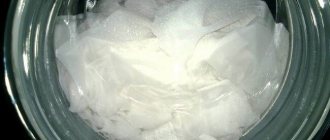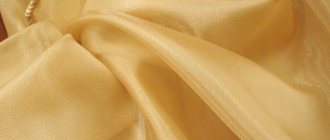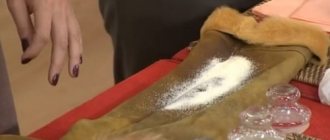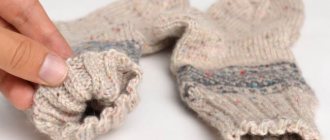Tulle is a window curtain that covers a room but allows sunlight to pass through. The material absorbs dirt, grease, moisture and dust. Over time, the fabric turns yellow-gray and requires cleaning. We recommend washing your curtains at least four times a year. This can be done manually or using a washing machine. Let's take a closer look at how to wash tulle in a washing machine.
Tulle is a delicate fabric that can be washed in the correct cycle. Small lightweight curtains can be hand washed in cool water. If the curtains are voluminous, wash them on a delicate cycle: wool, silk, hand wash at 30-40 ° C. It is better not to use or set the minimum spin speed: 400-500. It is recommended to use liquid detergents. Bleach is used to treat cotton and synthetic fabrics. It is better not to subject thin fabrics to active chemical and mechanical treatment.
Fabric Features
Detergent and temperature conditions are selected depending on the type of fabric. The mode in which to wash curtains depends on the characteristics of the material. Additionally, not all fabrics are machine washable.
Silk, chiffon, lurex, organza are best washed by hand and soaked for a few minutes. These fabrics are lightweight and do not cause problems when washing. In some cases, just dip the fabric in soapy water and rinse, and the curtains will be as good as new.
Thicker fabrics can be machine washed on a gentle cycle.
Preparing for washing
Remove curtains and check them before washing. There is no need to remove the plastic hooks, but make sure they are securely attached. Otherwise, they may get caught and tear the delicate fabric. If the plastic eyelets are removable, it is better to remove them so as not to damage them during washing. Leave non-removable metal parts as is.
Shake the curtains to remove dry dust. For especially pronounced stains, use laundry soap, ammonia or hydrogen peroxide in advance. Be careful to wet only this area. Grease stains can be removed by sprinkling them with starch. If you haven't washed your tulle in a while, pre-soak it in a small amount of detergent.
Weave thread curtains and secure at the ends with an elastic band. You can also tie them into bundles. This should be washed in a machine washable bag.
After all these manipulations, send the curtains to the wash.
How to remove stains of various origins from tulle curtains
In some cases, regular washing of tulle will not remove all stains. Sometimes even bleaching cannot remove a stubborn stain. The following proven methods will help you get rid of stubborn stains.
Removing soot and soot stains
Soot and soot stains are difficult to remove stains. To get rid of them, you will have to apply a three-stage treatment to the curtains.
Algorithm of actions:
- First of all, wash your tulle curtains by hand or machine. When washing, use powder or laundry soap.
- Then pour warm water (2 liters) into a small basin and add dishwashing detergent (2 tablespoons) to it.
- Dip a sponge into the soap solution and use it to whip up a rich foam.
The sponge must be new, not previously used for its intended purpose. - Apply the resulting foam to the soot and soot stains found on the tulle. Then rub it slightly into the textiles with soft and very gentle movements. Leave the curtains treated in this way for one hour.
- After the specified period, soak the tulle in a warm soda solution (for 10 liters of water at a temperature of 35–40 °C, take 5 tablespoons of soda). Tulle curtains should spend at least five hours in it.
Baking soda is a universal remedy for removing old soot stains. - After this, rinse them in cool water and hang them to dry. After drying, carefully inspect the tulle. If the stains are not completely removed, repeat the entire procedure again.
Getting rid of greasy stains
The tulle curtains that hang in the kitchen become almost completely saturated with grease over time. They need to be washed at least five times a year, since otherwise the dirt will penetrate deep into the textile fibers and it will be more difficult to remove them during washing.
A mixture of table vinegar and table salt is perfect for removing stains of this type. Vinegar breaks down grease perfectly on its own, but without salt it can strip dyed fabrics of their bright colors.
Instructions for removing grease stains from tulle curtains:
- Mix 5 tbsp in a small bowl. l. table nine percent vinegar and 2 tbsp. l. table salt.
Vinegar and table salt degrease the surface of the stain and penetrate deep into the fibers, decomposing the stain without leaving a residue. - Mix thoroughly and apply the mixture to greasy stains using an old toothbrush. Be very careful not to damage the delicate material. Leave the curtains for two or three hours.
- Then rinse the tulle in a mild soap solution and then in cool water.
This method is suitable for all types of delicate textiles, except muslin. After treatment with vinegar, muslin curtains may become loose and deformed.
How to wash tulle: detergents
Choose detergents specifically designed for delicate clothes and curtains. Liquid detergents are preferred because they dissolve completely even in cool water and are easy to rinse off.
Do not exceed the dosage of detergent. It is better to use a little less powder than the manufacturer recommends. When washing light fabrics, the detergent does not remain in the fibers and therefore foams heavily.
Powders and gels
Powder manufacturers have special lines for washing delicate items and tulle. The table below shows the main brands.
Table 1. Suitable detergents for washing tulle.
| Name | general description | price, rub. |
| "Cashmere Elixir for tulle and curtains" | For manual and automatic washing. Prevents the appearance of creases, removes yellowness, softens water, retains color, has a light aroma | 65 |
| "Vorsinka" | For manual and automatic washing. Prevents the appearance of creases, removes yellowness, softens water, retains color, has a light aroma | 65 |
| "Vorsinka" | For delicate fabrics and wool. Available in the form of loose and liquid powder | 62 |
| "Bingo Tulle" | Dry powder for automatic and hand washing. Has a whitening effect | 60 |
| Clovin Clever gardinen | Dry powder for automatic and hand washing. Has a whitening effect | 60 |
| Clovin Clever gardinen | Dry powder specially designed for curtains and tulle. Removes various stains and whitens. Sold in boxes and individual bags of 100 g | 45–120 |
You can save on detergents by using tourmaline or magnetic balls. They are thrown into the drum and they collect dirt. No need to add detergent.
Important! Please read the packaging carefully. Tulle and other delicate clothing can be washed with any solvent that dissolves at 30°C.
Bleaches
Many powders, especially those intended for white fabrics, include bleaching agents. In some cases, this is not enough, so you can use oxygen bleach to return the curtains to their former whiteness. They will refresh and whiten your curtains.
Feel free to bleach cotton, linen and synthetic tulle. Which brands are suitable for this job:
- Dr. Beckmann for curtains and drapes;
- "Vanish oxy";
- Frau Schmidt Super white tulle plus;
- "Sarma Active";
- "Eared Nanny";
- Bos bleach.
Household chemicals are suitable for bleaching nylons, silk fabrics and veils. What to do:
- Add six tablespoons of salt to a bucket of water and dissolve.
- Add 50 g of powder and mix.
- Pour in one tablespoon of ammonia and hydrogen peroxide.
- Immerse the washed tulle in the solution overnight.
- Rinse and dry.
You can simply use a saline solution (one tablespoon per liter of water) in which the curtain is soaked for 20 minutes after washing. Then it is squeezed out and dried without washing off the salt. The tulle will become white and slightly starchy.
How to bleach?
Has the snow-white tulle turned yellow and lost that spectacular diamond hue? Don't worry: there's nothing difficult about bringing back cool white.
For whitening use:
- Store products. Choose chlorine-free bleaches like Vanish, Synergetic, Dr. Beckman. These do not damage the structure and effectively remove yellowness even in cold water. For maximum whiteness, first soak the material in water with one of the products, and then add bleach to the washing powder.
- Home proven methods. Blue, brilliant green and potassium permanganate have approximately the same whitening effect. The essence of the methods is also similar: already washed curtains are soaked in a solution for 3-5 minutes (7 drops of brilliant green or ½ teaspoon of blue for 10 liters of water). Next, dry and iron as described above.
Don’t miss useful tips and follow the recommendations: proper washing and subsequent care will preserve the beauty of tulle, and therefore your interior.
How to wash tulle: algorithm for washing in a washing machine
Tulle is a delicate material, so it is logical to ask whether tulle can be washed in a washing machine. Automatic washing is quite acceptable under several conditions:
- setting the temperature depending on the type of fabric;
- low drum speed;
- gentle spin or no spin.
To ensure that the tulle retains its shape, small items should be placed in special covers for washing. You can also put items in a pillowcase.
Program
It is inconvenient to wash large volumes of fabric by hand, so washing machine manufacturers offer various programs that can be used to wash tulle. Let's look at the main models in the table.
Table 2. Tulle washing programs for different models.
| Typewriter | Program | Icon |
| "Ardo" (ARDO) | Delicate | Feather |
| Manual | Hand with pelvis | |
| Ariston ("Ariston") | Delicate | Flower |
| Beko (“Beko”) | Manual | – |
| Bosch ("Bosch") | Delicate | Dress with butterfly |
| Candy | Delicate | Feather |
| Electrolux (“Electrolux”) | Thin fabrics | Flower |
| Silk | Butterfly | |
| Wool/Handmade | Hank/Hand with basin | |
| Indesit | Delicate | Top |
| LG | Delicate | – |
| Samsung (“Samsung”) | Wool | – |
| Zanussi ("Zanussi") | Delicate | Flowers from 30°C and 40°C |
| Manual | Hand with pelvis (30°C) |
To save energy and water, an economy mode is available on some machines. It is also suitable for washing tulle as the water heats up to 40°C.
Attention! The drum speed should be kept to a minimum, otherwise thin fabrics may become deformed. Do not load the machine completely, so be careful not to wrinkle the fabric.
Temperature
The temperature depends on the type of fabric and the degree of soiling. Before washing, be sure to read the laundry label on the tulle and follow the instructions.
The optimal temperature for light curtains is 30-40 ° C. Cotton with polyester should be washed at 60 ° C, especially in case of heavy soiling. Nylon can be washed at 40-60°C as usual.
Spin
Regardless of the fabric type, set the speed to low. For delicate items, only 400-500 rpm is enough.
What fabrics should not be washed in the washing machine?
- lace tulle;
- silk;
- tulle;
- viscose;
- chiffon;
- lurex
Delicate items can be gently washed by hand without wringing them. Let the water drain freely.
How to wash tulle: features of drying and ironing
Do not use automatic machine drying. At the end of the cycle, shake the tulle and hang to dry. If the fabric is light (like mesh) and seems almost dry, you can immediately hang it on the window.
After hanging, the curtains will smooth out under their own weight, so there is no need to use an iron. If after washing or drying there are wrinkles on the cutting line, iron the product on a single or double iron. It is better to iron through damp cotton cloth or gauze.
But it is recommended to twist ribbed tulle. With intense ironing, the fabric stretches and the tulle becomes larger than it was.
How to wash tulle: practical tips
To make light curtains pleasing to the eye and last a long time, you should follow simple rules on how to wash tulle:
- wash curtains at least once every three months;
- Shake the fabric before soaking to remove dust;
- bleaches containing chlorine should not be used;
- do not twist the fabric;
- Do not iron wet white tulle as this will cause yellow stains.
Tulle is easy to wash if you follow the recommendations. Wash one item per cycle and do not overload the machine. For particularly delicate fabrics, special covers should be used.
Reasons for yellowness and grayness of tulle
Unfortunately, tulle in light shades begins to turn gray or yellow over time. Because of this, the room begins to look sloppy, and all the comfort disappears.
The longer a material is used, the more external factors affect it
The whiteness of textiles is lost due to the following reasons:
- accumulation of dust;
- solar radiation;
- smoking indoors;
- settling of smoke, grease and soot (relevant for kitchen curtains);
- excessively hot water when washing;
- influence of central heating.
It is recommended to wash tulle at least twice a year. It is most convenient to combine this procedure with seasonal washing of window glass (spring and autumn). Timely washing will prevent dirt from being absorbed deeply into the textile fibers, and it will be much easier to return the tulle to a fresh look.











